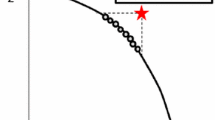Abstract
Multi-objective optimization, also known as multi-criteria decision making in the field of operations research, is a common task in many financial engineering problems. Several alternative approaches to multi-objective optimization have been proposed in operations research. Depending on when the so-called decision maker introduces his preferences, three approaches to multi-criteria decision making can be distinguished: a priori decision making, interactive decision making, and finally a posteriori decision making. This paper suggests a new interactive multi-criteria decision making scheme which combines these three approaches in a single multi-objective optimization framework. In contrast to most operations research approaches, the new scheme is based on evolutionary algorithms due to of their flexibility regarding the type of objectives and constraints. This way the new scheme allows de novo programming, which enables the decision maker to refine the problem definition and to reduce the size of the objective space iteratively.
Preview
Unable to display preview. Download preview PDF.
Similar content being viewed by others
References
Benayoun, R., de Montgolfier, J., Tergny, J., Laritchev, O.: Linear Programming with Multiple Objective Functions: Step Method (STEM). Mathematical Programming 1(3), 366–375 (1971)
Deb, K.: Multi-Objective Optimization using Evolutionary Algorithms. John Wiley & Sons, LTD., Chichester (2001)
Deb, K., Chaudhuri, S.: I-EMO: An interactive evolutionary multi-objective optimization tool. KanGAL Report 2005003, Kanpur Genetic Algorithms Laboratory (KanGAL), Indian Institute of Technology, Kanpur, PIN 208016, India (2005)
Geoffrion, A.M., Dyer, J.S., Feinberg, A.: An interactive approach for multi-criterion optimization, with an application to the operation of an academic department. Management Science 12(4), 357–368 (1972)
Haimes, Y.Y., Lasdon, L.S., Wismer, D.A.: On a bicriterion formulation of the problems of integrated system identification and system optimization. IEEE Transactions on Systems, Man and Cybernetics 1(3), 296–297 (1971)
Markowitz, H.M.: Portfolio Selection: efficient diversification of investments. John Wiley & Sons, LTD., Chichester (1959)
Miettinen, K.M.: Nonlinear Multiobjective Optimization. Kluwer Academic Publishers, Dordrecht (1998)
Pareto, V.: Manual of Political Economy. The MacMillan Press Ltd., Basingstoke (1971) (the original edition is French in 1927)
Ranjithan, S.R., Chetan, S.K., Dakshina, H.K.: Constraint method-based evolutionary algorithm (CMEA) for multiobjective optimization. In: Zitzler, E., Deb, K., Thiele, L., Coello Coello, C.A., Corne, D.W. (eds.) EMO 2001. LNCS, vol. 1993, pp. 299–313. Springer, Heidelberg (2001)
Romero, C.: Handbook of Critical Issues in Goal Programming. Pergamon Press, Oxford (1991)
Steuer, R.E.: Multiple Criteria Decision Making and Risk Analysis Using Microcomputers. In: The Tchebycheff Procedure of Interactive Multiple Objective Programming, pp. 235–249. Springer, Heidelberg (1989)
Streichert, F., Ulmer, H.: JavaEvA - a java framework for evolutionary algorithms. Technical Report WSI-2005-06, Centre for Bioinformatics Tübingen, University of Tübingen (2005)
Wierzbicki, A.P.: Multiple Criteria Decision Making Theory and Applications. In: The Use of Reference Objectives in Multiobjective Optimization. LNEMS, vol. 177 pp. 468–486 (1980)
Zadeh, L.: Optimality and non-scalar-valued performance criteria. IEEE Transactions on Automatic Control 8, 59–60 (1963)
Zeleny, M.: Multiple Criteria Decision Making. In: Compromise Programming. University of South Carolina, Columbia, South Carolina, USA, pp. 262–301 (1973)
Zeleny, M.: The evolution of optimality: De novo programming. In: Coello Coello, C.A., Hernández Aguirre, A., Zitzler, E. (eds.) EMO 2005. LNCS, vol. 3410, pp. 1–13. Springer, Heidelberg (2005)
Author information
Authors and Affiliations
Editor information
Editors and Affiliations
Rights and permissions
Copyright information
© 2006 Springer-Verlag Berlin Heidelberg
About this paper
Cite this paper
Streichert, F., Tanaka-Yamawaki, M. (2006). A New Scheme for Interactive Multi-criteria Decision Making. In: Gabrys, B., Howlett, R.J., Jain, L.C. (eds) Knowledge-Based Intelligent Information and Engineering Systems. KES 2006. Lecture Notes in Computer Science(), vol 4253. Springer, Berlin, Heidelberg. https://doi.org/10.1007/11893011_83
Download citation
DOI: https://doi.org/10.1007/11893011_83
Publisher Name: Springer, Berlin, Heidelberg
Print ISBN: 978-3-540-46542-3
Online ISBN: 978-3-540-46544-7
eBook Packages: Computer ScienceComputer Science (R0)




